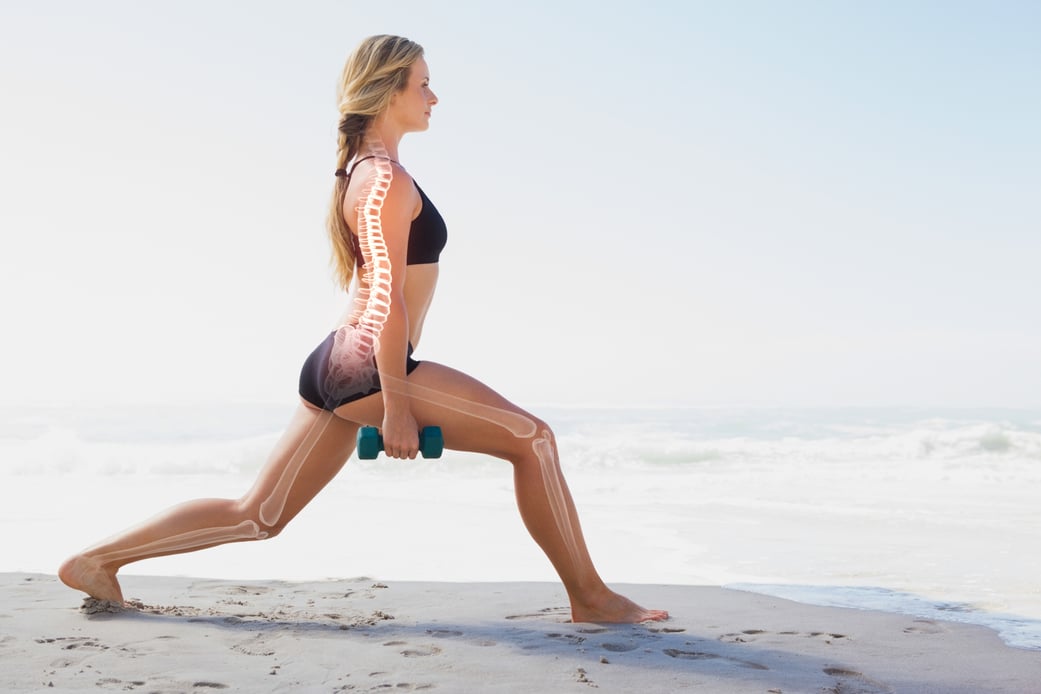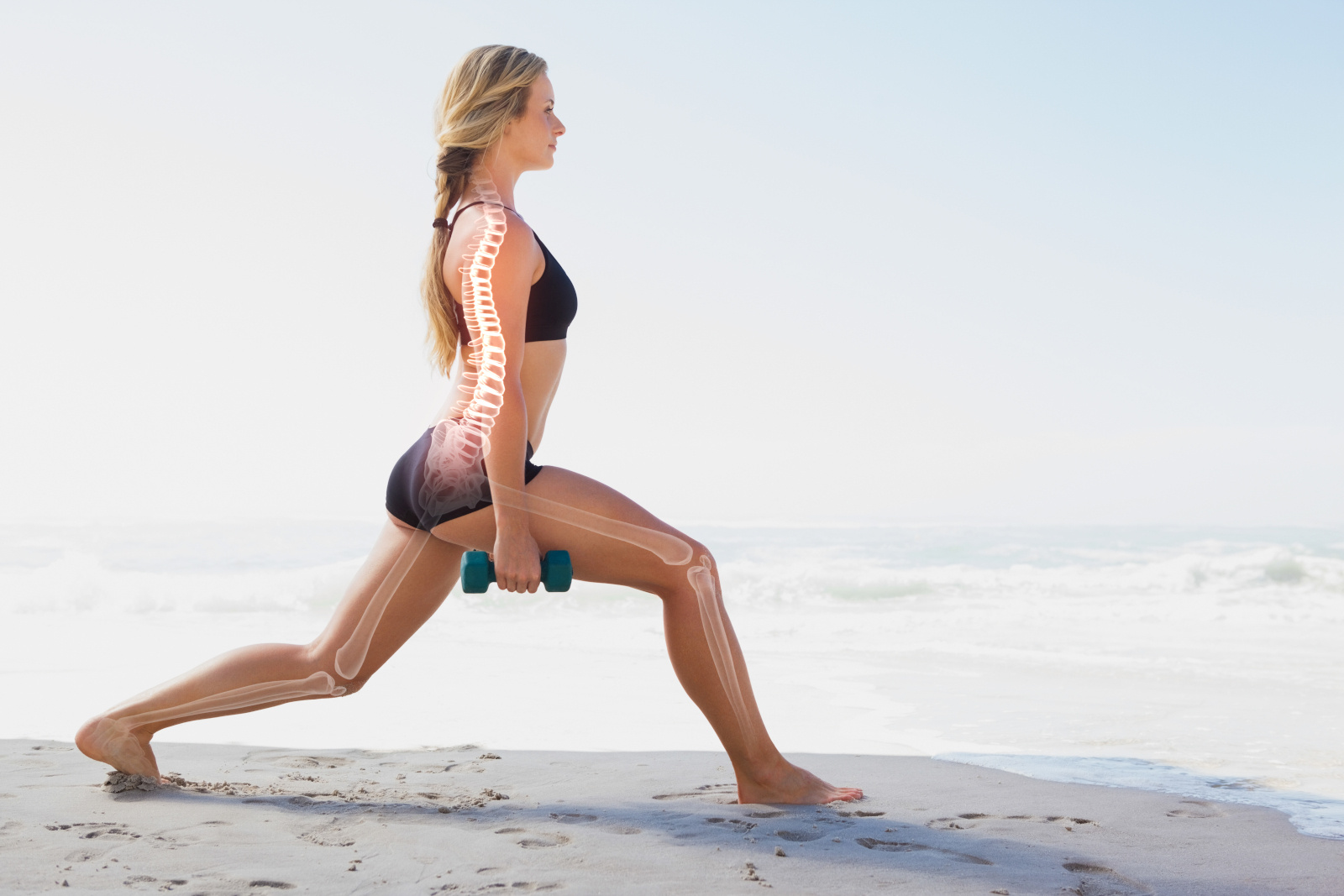
A risk assessment and potential bone density scan (DEXA) can identify bone health and potential problem areas. If conducted prior to menopause, preventative steps can be taken to improve bone mass in advance of menopause when bone deteriorates at an accelerated rate. A DEXA can also reveal information about muscle composition and fat mass. Therefore, it provides the same opportunity for enhancing lean muscle mass prior to estrogen decline. Current medical guidelines advise physicians to consider a DEXA scan for women over 65 at moderate risk, only advising it for a younger demographic (50 to 69) if there are risk factors for severe bone loss (1,7,8). The Society for Women’s Health Research (SWHR) convened an expert review of these clinical guidelines. It concluded that given rapid bone loss can occur in women during early postmenopausal years, leading to increased risk for osteoporosis, there is a missed opportunity for health promotion and prevention by not focusing on bone health during perimenopause rather than until after 65 (well into postmenopause). The average age of menopause in North America is 51 years old (range 45 to 55 years). Waiting to engage women more than 10 years postmenopause means they cannot introduce preventive lifestyle practices and potential treatment options that may preserve bone density and reduce fall and fracture risk.
In fact, the Working Group concluded that the guidelines should reduce the age for screening to perimenopause (ages 40-50) to provide a baseline assessment of bone health before the majority of rapid postmenopausal bone loss has already occurred. This baseline can be used to monitor changes throughout the menopause transition ( 8 ).
Currently, DEXA scanning rates are low even among women within the recommended guidelines. A study of data from 2008 to 2014 found overall screening rates were: 21.1%, 26.5%, and 12.8% among women ages 50–64, 65–79, and 80+ years, respectively. Even after fracture, very few providers screen, meaning women need to self-advocate and raise the issue themselves with their physicians (6).


What Can I Do?
Baseline Diagnostics: DEXA Bone Density Scan
Should you get a bone density scan? If you have several of the risk factors above, it might be a good idea to get a bone density scan. Not only will a DEXA give you a baseline of your current bone, muscle, and fat body composition, it can help create a tailored bone health promotion plan to prepare you for postmenopause.
DEXA uses X-ray technology so while it is safe, it does provide some radiation exposure which is worth keeping in mind when considering getting one done. You can meet with your physician to review your risk factors and request a referral for a DEXA scan. Many hospitals and private imaging clinics conduct them. Some private clinics will complete a DEXA without a referral.
Meet Alexia, she is a 47 year old woman who smoked since she was 15. Alexia led a ‘party lifestyle’ up until she married and gave birth to her son, David. Recently, however, she separated from her husband and herb son left for university, moving across the country. Alexia has been struggling and returned to her party lifestyle which includes smoking, excessive drinking, poor food choices and little physical exercise. After starting to realize she needs a lifestyle change, but she does not know where or how to start. As she started to educate herself, she is realizing she is at risk for poor bone health. What can she do?


Take the Quiz: What Are Your Risk Factors for Osteoporosis/Osteopenia
Listed below are the major risk factors for osteoporosis and osteopenia. Review the list of risk factors and answer ‘yes’ or ‘no’ to each item. Sharing this with your PAUZ clinician-it will also help them in their assessment.
-
Do you have a history of breaking a bone in a minor accident?
-
Do you suffer joint pain, inflammation, or swelling?
-
Do you have any disorder associated with osteoporosis such as rheumatoid arthritis or Chron’s disease?
-
Do you have nutrient absorption issues such as gluten?
-
Do you have a parent who has broken a hip?
-
Have you lost half or more of your teeth?
-
Do you have bone loss documented by a prior bone density test?
-
Are you taking any of the following medications that can damage your bones?
-
-
Corticosteroid drug use for three months or more (e.g. prednisone, steroid inhalers)
-
Use of acid blocking medications, proton pump inhibitors (common ones include omeprazole, lansoprazole, and pantoprazole)
-
Antidepressants (certain types of antidepressants are associated with bone loss.
-
-
-
Do you smoke?
-
Do you drink on average, 2 or more servings of alcohol per day?
-
Do you consume on average, 2 servings of soda, coffee, caffeinated beverages per day?
-
Do you eat 2 to 3 cups of vegetables and 1 to 2 cups of fruit per day?
-
Do you have a low body weight (e.g. >120 pounds)?
-
Do you exercise less than 30 minutes per day, 4 times per week?
-
Are you an elite athlete or do you have an eating disorder (anorexia, bulimia)?
-
Do you have daily exposure to the sun without sunscreen (e.g. 15 min/day on your arms)?
-
Are you in perimenopause or menopause?
References
-
https://choosingwiselycanada.org/wp-content/uploads/2017/05/DEXA-EN.pdf
-
Chidi-Ogbolu N, Baar K. Effect of Estrogen on Musculoskeletal Performance and Injury Risk. Front Physiol. 2019 Jan 15;9:1834. doi: 10.3389/fphys.2018.01834. PMID: 30697162; PMCID: PMC6341375.
-
Perry SD, Bombardier E, Radtke A, Tiidus PM. Hormone replacement and strength training positively influence balance during gait in post-menopausal females: a pilot study. J Sports Sci Med. 2005 Dec 1;4(4):372-81. PMID: 24501551; PMCID: PMC3899653.
-
Melton LJ 3rd, Chrischilles EA, Cooper C, Lane AW, Riggs BL. Perspective. How many women have osteoporosis? J Bone Miner Res. 1992 Sep;7(9):1005-10. doi: 10.1002/jbmr.5650070902. PMID: 1414493.
-
Hansen D, Pelizzari P, Pyenson B. Medicare Cost of Osteoporotic Fractures-2021 Updated Report. Milliman, Inc.: Seattle, WA, 2021.
-
McPhee C, Aninye IO, Horan L. Recommendations for Improving Women's Bone Health Throughout the Lifespan. J Womens Health (Larchmt). 2022 Dec;31(12):1671-1676. doi: 10.1089/jwh.2022.0361. Epub 2022 Nov 7. PMID: 36346282; PMCID: PMC9805882.
-
LeBoff MS, Greenspan SL, Insogna KL, et al. The clinician’s guide to prevention and treatment of osteoporosis. Osteoporos Int 2022;33(10):2049–2102
-
US Preventive Services Task Force, Curry SJ, Krist AH, et al. Screening for osteoporosis to prevent fractures: US Preventive Services Task Force recommendation statement. JAMA 2018;319(24):2521–2531.
-
Snow CM, Shaw JM, Winters KM, Witzke KA. Long-term exercise using weighted vests prevents hip bone loss in postmenopausal women. J Gerontol A Biol Sci Med Sci. 2000 Sep;55(9):M489-91. doi: 10.1093/gerona/55.9.m489. PMID: 10995045.
-
Shaw JM, Snow CM. Weighted vest exercise improves indices of fall risk in older women. J Gerontol A Biol Sci Med Sci. 1998 Jan;53(1):M53-8. doi: 10.1093/gerona/53a.1.m53. PMID: 9467434.
-
Clark D, Nakamura M, Miclau T, Marcucio R. Effects of Aging on Fracture Healing. Curr Osteoporos Rep. 2017 Dec;15(6):601-608. doi: 10.1007/s11914-017-0413-9. PMID: 29143915; PMCID: PMC6517062.
-
https://osteoporosis.ca/medical-conditions-that-can-cause-bone-loss-falls-and-or-fractures/
-
Rondanelli M, Faliva MA, Tartara A, Gasparri C, Perna S, Infantino V, Riva A, Petrangolini G, Peroni G. An update on magnesium and bone health. Biometals. 2021 Aug;34(4):715-736. doi: 10.1007/s10534-021-00305-0. Epub 2021 May 6. PMID: 33959846; PMCID: PMC8313472.
-
Sharma T, Mandal CC. Omega-3 fatty acids in pathological calcification and bone health. J Food Biochem. 2020 Aug;44(8):e13333. doi: 10.1111/jfbc.13333. Epub 2020 Jun 17. PMID: 32548903.
-
Orchard TS, Pan X, Cheek F, Ing SW, Jackson RD. A systematic review of omega-3 fatty acids and osteoporosis. Br J Nutr. 2012 Jun;107 Suppl 2(0 2):S253-60. doi: 10.1017/S0007114512001638. PMID: 22591899; PMCID: PMC3899785.
-
https://www.sciencedirect.com/science/article/abs/pii/S1551714415000191
-
König D, Oesser S, Scharla S, Zdzieblik D, Gollhofer A. Specific Collagen Peptides Improve Bone Mineral Density and Bone Markers in Postmenopausal Women-A Randomized Controlled Study. Nutrients. 2018 Jan 16;10(1):97. doi: 10.3390/nu10010097. PMID: 29337906; PMCID: PMC5793325.
.png?width=50&name=Take%20control%20over%20(13).png)


%20(960%20x%20540%20px)%20(1200%20x%20630%20px)%20(1600%20x%20900%20px)%20(1600%20x%20900%20px).jpg?width=352&name=Untitled%20(560%20x%20420%20px)%20(960%20x%20540%20px)%20(1200%20x%20630%20px)%20(1600%20x%20900%20px)%20(1600%20x%20900%20px).jpg)
